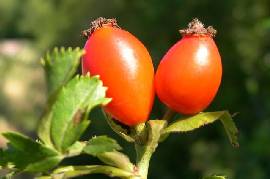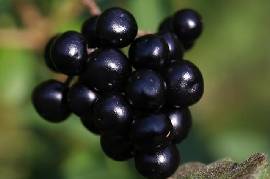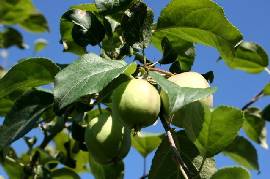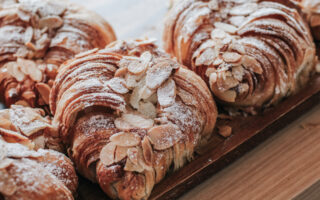French Flavour of the Month – wild fruit and berries


Autumn is the time when the chemins and gardens of France fill with wild fruit and berries. Here are recipes for three of the most common
ROSEHIP SYRUP
The fruit of the wild rose can be gathered between August and the end of October when the fruit is ripe. A lovely deep red and rich in vitamin C, it makes a delicious syrup that is perfect with icecream, yoghurt and pancakes.
Makes about 500ml
700g fresh rosehips
1kg fruit sugar
1 tablespoon lemon juice
½ tablespoon rosewater (optional)
Equipment needed: Sterilised syrup bottles
Wash the fruit and remove those that are damaged as well as the flower remnants (the black bits at the end). Place the fruit in a pan, cover with water and simmer for 20 minutes until soft. Using a fine sieve, strain the mixture into a bowl, then return the pulp left in the sieve to the saucepan. Add the same amount of water as pulp and strain again. Repeat the process for a third time.
Measure the juice, then pour into a clean saucepan. Add 1 cup of fruit sugar to every 2 cups of juice. Add the lemon juice (and rosewater if using) and simmer for 20 minutes, regularly removing the froth on the top with a metal spoon.
Pour into sterilised bottles (the easiest way to sterilise the bottles is to place them in a lightly warm oven until heated) and seal while the juice is still warm.
 SLOE VODKA OR GIN
SLOE VODKA OR GIN
The fruit of the blackthorn bush is usually gathered from October, although it is said that they are at their best after the first frost.
Makes about 1 ½ litres
450g sloes
1 litre vodka or gin
450g caster sugar
Equipment needed: 2 litre bottle
Wash the fruit, and remove those that are damaged. Then place the fruit in a plastic bag and put in the freezer until they are frozen solid, about two days, and the fruit starts to burst (about two days) to release the fruit.
Defrost the sloes and put them in a sterilised jar or glass bottle. Pour in the vodka and add the sugar. Attach the lid and shake, doing this every other day for a month, and then occasionally over the next three months.
Then strain and bottle the liquid. You can drink it for Christmas, although the longer you leave it the better it will taste!
 CRAB APPLE JELLY
CRAB APPLE JELLY
A small tart fruit, usually pale green to yellow in colour, from a small shrubby tree found in woodland. The jelly is good with cold meats or roast
Makes about 3 litres
4kg crab apples
1kg caster sugar
Juice of one lemon
Equipment needed: Muslin; Preserving jars
Wash the fruit and remove the blossom heads and bruised sections of the fruit. Put the fruit in a saucepan with enough water to cover the fruit and then bring to the boil. Simmer until the fruit is soft, about half an hour.
Make a bag using about three layers of muslin and pour the pulp through it, into a saucepan below. Leave the pulp to drip through overnight. Don’t squeeze the bag because that will cloud the jelly.
The next day, measure the juice, and mix in the sugar at a ratio of 10 parts juice to seven of sugar. Then add the lemon juice, and bring to the boil. Keep at a rolling boil for 40 minutes, skimming the froth from the top with a metal spoon. Towards the end of the 40 minutes start testing the jelly – coat the back of a chilled spoon with the liquid. The jelly is ready when it solidifies on the back of the spoon.
When done, pour into warm, sterilised preserving jars and seal tightly. Store in a cool dark place.
Share to: Facebook Twitter LinkedIn Email
By FrenchEntrée
Leave a reply
Your email address will not be published. Required fields are marked *



